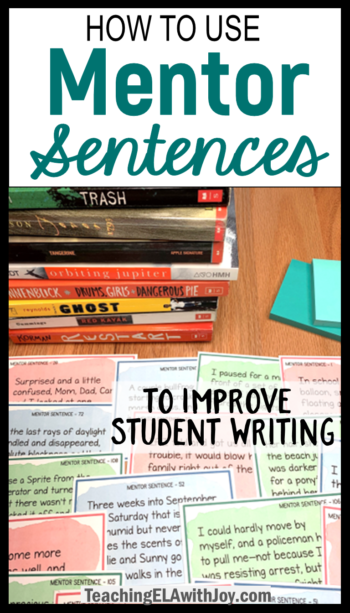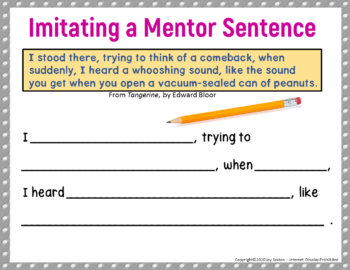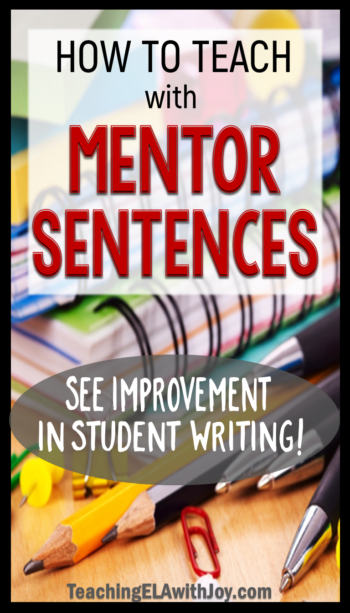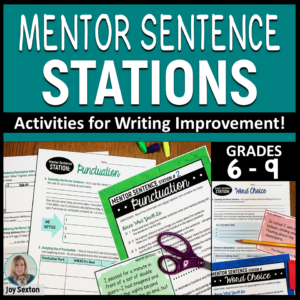
We all want to find ways to improve our students’ writing, but sometimes it’s hard to know just where to begin. When we get our eyes on that first batch of assignments, we see weaknesses everywhere! Fortunately, we don’t have to go back to square one and re-teach all the basics in order to see writing growth. Have you tried using mentor sentences in your instruction? These models, excerpted from young adult literature, serve amazingly well to help students write stronger sentences.
The Benefits
By using mentor sentences from experienced authors, you can expect to see improvement in student writing. Here’s why:
- The mentor sentences prompt discussions about writing as students analyze what the writer has done in each sentence
- The mentor sentences exemplify necessary writing skills such as use of punctuation and verb tense consistency
- Students encounter interesting writing styles, including use of varied sentence structures, description, and figurative language
- Students gain practice by imitating the mentor sentences, using their own ideas
How to Locate Mentor Sentences
When I search for mentor sentences, I look for well-written sentences that are interesting and attention-grabbing. I also want sentences that exemplify skills that students need practice with. I recommend looking through your students’ favorite young adult novels. Skim the pages until your eyes land on that awesome sentence. For me, if it’s a compound or complex sentence, it’s a contender. If it contains some descriptive language, even better. Maybe a comma rule is exemplified, and the sentence contains a simile! Do you see how I’m getting excited?
One thing to keep in mind is be sure the mentor sentences you choose can be imitated by your students without too much trouble. Some sentences are beautifully written, but the task seems difficult when I put myself in the students’ place trying to imitate it. Here’s an example:

This particular sentence is well-written, but somewhat difficult for students to imitate. I tried to quickly create some imitation sentences in my mind putting myself in a middle schooler’s mindset, and it wasn’t easy. So I decided to skip this one, and I went on to find plenty of others that were more adaptable for imitations.
It’s also important to find mentor sentences that contain different levels of challenge, so you can differentiate instruction. Some students need to work with a simple sentence that contains rich description and/or figurative language. Other students will like the higher level of challenge a compound-complex sentence offers.
How to Teach Using Mentor Sentences
Good teaching always involves modeling, so you’ll want to choose a few mentor sentences to work with as a class. You can deliver a MINI-LESSON like this:
- project the sentence on your whiteboard (include the title and author from your source)
- ask students to study the sentence and think about some things the author has done in the sentence
- students can discuss with a partner and/or list responses on an index card; students then share their ideas whole class
- prompt students so they continue to notice characteristics they may have missed (even small things)
- highlight parts of speech in the sentence, questioning students on certain words
- tell students that they, too, can write like an experienced author. Draw out a “fill in” diagram that will guide them in imitating the mentor sentence (see example below). Explain to students that they should change the subject of the sentence. Provide examples such as I, My sister, Hank, The lady on the bus, etc. They should understand that imitating is about following the pattern, or structure, not the ideas.
- Lastly, show them an imitation you created. Use the same fill-in template.
This fill-in diagram is a scaffold that helps students use ideas of their own to create an imitation of the mentor sentence. After your modeling, they will be eager to write (and share)!

Class Activities Using Mentor Sentences
One fun group activity involving mentor sentences is a gallery walk. This strategy works especially well if you’re trying to teach a concept, like compound sentences or writing with figurative language. First, locate 6-8 exemplar sentences that contain the particular technique. Write each sentence on large poster paper and place them around the classroom. Small groups can rotate and write their observations all around the sentence, or brainstorm an imitation of the mentor sentence and record it there.
You could also use stations, and set a different mentor sentence at each. Then assign the tasks you want students to accomplish. You can even have the same tasks for each station to make it easy for you—just list them on your whiteboard. It also helps to set a time limit and use a timer. (Try classroomscreen.com) Students get up and rotate to discuss and work with all the different sentences.
Or, if you’d like students to remain in their small groups, let each group pull a mentor sentence out of a hat as you walk around. Students work together to discuss key characteristics and write their own imitation sentence. Then groups can share their original and reveal their own creation to the class.
I hope you are eager to start using mentor sentences in your ELA classroom! Once students get familiar with mentor sentences, they will want to locate their own examples from independent novels. Challenge them to explain why they think their choices are strong, well-written sentences.
If you’d like to teach with Mentor Sentence Stations that are ready to go, check out my latest resource! It contains 8 different stations, along with 120 mentor sentences differentiated for 3 levels of challenge. There’s even a PowerPoint Mini-Lesson to kick it all off. Both print and digital versions are included! Click the image below to take a look.
If you’d like ideas about managing station work, read my blog post: Secrets to Managing Station Work in Middle School






I love your resources. Thanks!
This is so awesome! I loved doing this as an undergrad student with my professors. Eager to try it with my students.